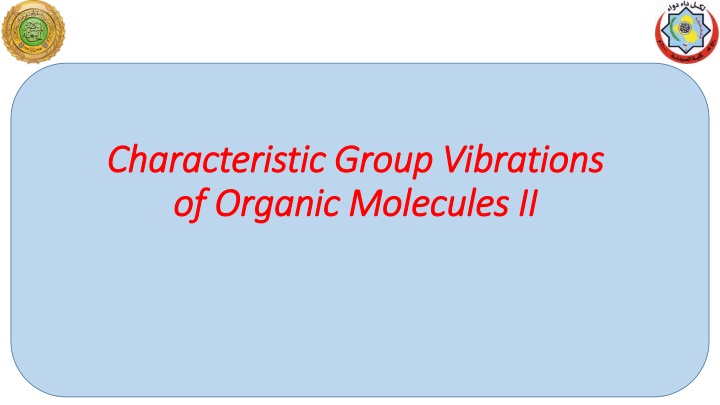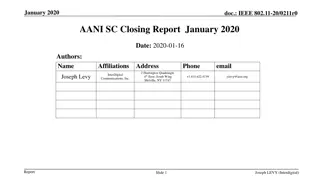
Characteristic Group Vibrations of Organic Molecules II
Explore the characteristic group vibrations of organic molecules, including aromatic hydrocarbons and alcohols/phenols. Learn about the unique absorption bands and frequencies associated with different functional groups, such as C-H stretching and bending in aromatic compounds and H-bonding in alcohols/phenols. Discover how spectroscopy can differentiate between various organic compounds based on their molecular vibrations.
Download Presentation

Please find below an Image/Link to download the presentation.
The content on the website is provided AS IS for your information and personal use only. It may not be sold, licensed, or shared on other websites without obtaining consent from the author. If you encounter any issues during the download, it is possible that the publisher has removed the file from their server.
You are allowed to download the files provided on this website for personal or commercial use, subject to the condition that they are used lawfully. All files are the property of their respective owners.
The content on the website is provided AS IS for your information and personal use only. It may not be sold, licensed, or shared on other websites without obtaining consent from the author.
E N D
Presentation Transcript
Characteristic Group Vibrations Characteristic Group Vibrations of Organic of Organic Molecules II Molecules II
Aromatic Hydrocarbons Aromatic (C-H) stretching (3130-3030) cm-1 Aromatic (C-H) bending (900-650) Aromatic (C=C-C ) (1615-1580) (1510-1450) cm-1 Monosubstitution (710-690) cm-1 (1225-950) cm-1 o o m m (770-730) cm-1 Disubstitution (ortho) Aromatic ring (1600-1500) cm-1 (meta) (810-750) (900-860) cm-1 (para) (860-800) cm-1 p
Aromatic Hydrocarbons Monosubstituted aromatic ring CH3 Monosubstitution (710-690) cm-1 Aromatic (C-H ) stretching (3130-3030) cm-1 Aromatic (C=C-C ) (1510-1450) cm-1
Disubstituted aromatic ring (para) (C-H) stretching 1650-1400 cm-1 O-H CH3 (C=C) in-plane
The combination and overtone bands in 2000-1650 cm-1 region are also characteristics of aromatic rings. Moreover, they are very weak and are observed only in the case of concentrated solutions of highly symmetric benzene derivatives.
Alcohols and Phenols The (C-O) and (O-H) absorption bands can be recognised from 3700 to 3400 cm-1 The presence of (N-H) or moisture causes similar results. The exact position and shape of this band depends largely on the degree of H-bonding. A strong and sharp peak in the region as higher 3700 cm-1 in gaseous or extremely dilute solutions represents unbounded or free OH group(s).
Alcohols and Phenols Alcohols and phenols in condensed phases (bulk liquid, KBr discs, concentrated solution etc.) are strongly hydrogen bonded, usually in the form of dynamic polymeric association; dimmers, trimers, tetramers etc., and cause broadened bands at lower frequencies. H-bonding involves a lengthening of the original (O-H) bond. This bond is consequently weakened, force constant is reduced and so the stretching frequency is lowered. ~1050 cm-1 ~1100 cm-1 ~1150 cm-1 (C-O) stretching(1250-1000) cm-1 (C-O) with (C-C) stretching mode These two bands can differentiate the types of alcohols and phenols
Enols and Chelates Since these bonds are not easily broken on dilution by an inert solvent, free (O-H) may not be seen at low concentrations. In structures, such as 2,6-di -t-butylphenol, in which steric hindrance prevents hydrogen bonding, no bounded O-H band is observed, not even in spectra of neat samples. O-H stretching 2880 cm-1 NO bounded O-H
Ethers and Epoxides Asymmetric (C-O-C) stretching 1150-1000 cm-1 But a band in this region is also observed in other oxy compounds like alcohols, aldehydes, ketones, and acids etc. Therefore, we consider the possibility that a compound is ether or an epoxide only if the unknown oxy compound shows no absorption bands in (O-H) (3750-3000 cm-1) or carbonyl (1850-1550 cm-1) regions.((How can you recognize ether from other carbonyl groups?)) The conjugation of ether with (C=C) bond or phenyl ring shifts the (C-O-C) symmetric stretching to ~1250 cm-1. The resonance increases the bond order from single to partial double bond and so higher the force constant and higher the absorption frequency.
Carbonyl compounds The absorption peak for (C=O) stretching in the region 1870 to 1600 cm-1is perhaps the easiest band to recognize in IR spectrum and is extremely useful in analysis of carbonyl compounds. The changes in (C=O) stretching frequency in various carbonyl compounds can be explained by considering: 1. Electronic and mass effects of neighboring substituents 2. Resonance effects ( both C=C and heteroatom lone pair) 3. Hydrogen bonding (inter and intramolecular) 4. Ring strain etc. It is customary to refer to the absorption frequency of a saturated aliphatic ketone at 1715 cm-1
a. Aldehydes and Ketones Aliphatic aldehydes show strong (C=O) stretching in the region of 1740 1725 cm-1. The conjugation of an aldehyde to a (C=C) or a phenyl group lowers(C=O) stretching by ~ 30 cm-1. This effect is seen in benzaldehyde in which aryl group is attached directly to the carbonyl group and shifts (C=O) stretch to 1701 cm-1. The higher (C-H) stretching band (2860-2800 cm-1) of aldehyde is often buried under aliphatic C-H band. But the lower C-H band at 2760-2700 cm-1 is usually used to distinguish aldehydes from ketones. The C-H bending vibrations appear between 945-780 cm-1.
a. Aldehydes and Ketones 1720-1700 cm-1
a. Aldehydes and Ketones In case of cyclic ketones, the coupling between (C=O) stretching and C(=O)-C single bond causes increase in C=O stretching frequency as the C-C(=O) angle decreases.
b. Carboxylic Acids, Esters and Carboxylates In case of carboxylic acids, the appearance of strong (C=O) stretching along with broad hydroxyl peak centered at ~ 3000 cm-1in an IR spectrum certainly shows the presence of carboxylic acid. In addition a medium intensity (C=O) stretch appears between 1320 1260 cm-1. In dilute solutions, the carboxylic acids attain monomeric structures and the inductive effect of oxygen shifts the (C=O) absorption band to higher values 1760 1730 cm-1than observed in ketones (1710 cm-1). 3400-2500 cm-1
b. Carboxylic Acids, Esters and Carboxylates 1750-1730 cm-1 In case of , -unsaturated or aryl carboxylic acids esters, the esters of due to conjugation absorb at lower frequency. 1300-1000 cm-1 If in an ester, (C-O) oxygen bears electron-withdrawing group like vinyl, Ph etc., then the (C=O) stretching is shifted to higher values (~1770 cm-1) This increases the electron-withdrawing ability of oxygen causing increase in carbonyl double bond character. In cyclic esters (lactones) (C=O) stretching is shifted to higher frequency with decreasing ring size. Because of ring strain. In salts of carboxylic acids, expected due to partial (C=O) bond character, the C=O stretching frequency is shifted to lower frequencies at ~ 1600 cm-1.
c. Acid Chlorides and Anhydrides Both carboxylic acid halides and anhydridesshow strong (C=O) absorptions at frequencies > 1800 cm-1 , and are easily differentiated form other carbonyl compounds. The acid anhydrides show two absorption bands in carbonyl region at 1820 cm-1 due to symmetric and at 1760 cm-1 due to asymmetric stretching vibrations. In case of anhydrides of conjugated carboxylic acids, the frequencies due to these bands are shifted to 1775 and 1720 cm-1.
c. Acid Chlorides and Anhydrides The effect of conjugation is clearly visible in IR spectrum of benzoyl anhydride. The strong and broad (C-O) stretching vibrations appear in the region 1300 900 cm-1. In case of acid chlorides, the (C=O) stretching frequencies appear at 1810-1790 cm-1which is attributed to high electronegativity of chlorine
d. Amides In case of amides strong resonance participation of lone pair of electrons by amide nitrogen weakens the carbonyl bond, Consequently: (C=O) amide < (C=O) ketone The (C=O) stretching band in IR spectra of amide is called amide I band. In primary and secondary amides, (N-H) deformation band appears in the region 1655 - 1595 cm-1and is called amide II band. In the solid or pure liquid state, primary amides, which are highly hydrogen bonded, exhibit two N-H stretching bands, one at 3550 cm-1 due to N-H asymmetric stretching and other at 3180 cm-1 due to N-H symmetric stretching. 1680-1630 cm-1 20-50 cm-1 lower than ketones In dilute solutions, due to lowering in degree of hydrogen bonding, the absorption bands shift to higher frequencies at 3500 and 3400 cm-1, respectively. The secondary amides show only one (N-H) band at ~ 3300 cm-1.











